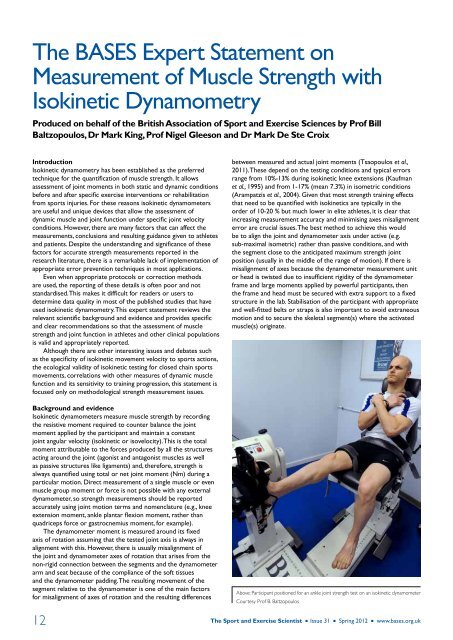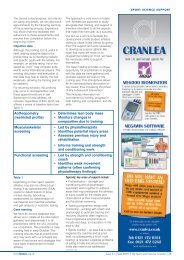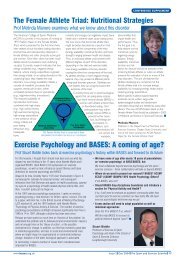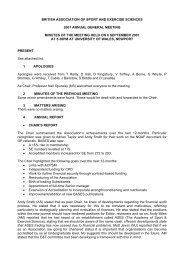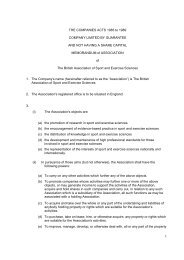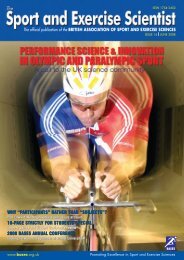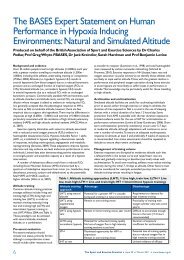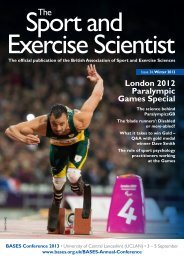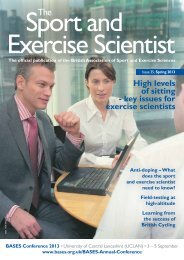Issue 31 Spring 2012 - Bases
Issue 31 Spring 2012 - Bases
Issue 31 Spring 2012 - Bases
You also want an ePaper? Increase the reach of your titles
YUMPU automatically turns print PDFs into web optimized ePapers that Google loves.
The BASES Expert Statement on<br />
Measurement of Muscle Strength with<br />
Isokinetic Dynamometry<br />
Produced on behalf of the British Association of Sport and Exercise Sciences by Prof Bill<br />
Baltzopoulos, Dr Mark King, Prof Nigel Gleeson and Dr Mark De Ste Croix<br />
Introduction<br />
Isokinetic dynamometry has been established as the preferred<br />
technique for the quantification of muscle strength. It allows<br />
assessment of joint moments in both static and dynamic conditions<br />
before and after specific exercise interventions or rehabilitation<br />
from sports injuries. For these reasons isokinetic dynamometers<br />
are useful and unique devices that allow the assessment of<br />
dynamic muscle and joint function under specific joint velocity<br />
conditions. However, there are many factors that can affect the<br />
measurements, conclusions and resulting guidance given to athletes<br />
and patients. Despite the understanding and significance of these<br />
factors for accurate strength measurements reported in the<br />
research literature, there is a remarkable lack of implementation of<br />
appropriate error prevention techniques in most applications.<br />
Even when appropriate protocols or correction methods<br />
are used, the reporting of these details is often poor and not<br />
standardised. This makes it difficult for readers or users to<br />
determine data quality in most of the published studies that have<br />
used isokinetic dynamometry. This expert statement reviews the<br />
relevant scientific background and evidence and provides specific<br />
and clear recommendations so that the assessment of muscle<br />
strength and joint function in athletes and other clinical populations<br />
is valid and appropriately reported.<br />
Although there are other interesting issues and debates such<br />
as the specificity of isokinetic movement velocity to sports actions,<br />
the ecological validity of isokinetic testing for closed chain sports<br />
movements, correlations with other measures of dynamic muscle<br />
function and its sensitivity to training progression, this statement is<br />
focused only on methodological strength measurement issues.<br />
Background and evidence<br />
Isokinetic dynamometers measure muscle strength by recording<br />
the resistive moment required to counter balance the joint<br />
moment applied by the participant and maintain a constant<br />
joint angular velocity (isokinetic or isovelocity). This is the total<br />
moment attributable to the forces produced by all the structures<br />
acting around the joint (agonist and antagonist muscles as well<br />
as passive structures like ligaments) and, therefore, strength is<br />
always quantified using total or net joint moment (Nm) during a<br />
particular motion. Direct measurement of a single muscle or even<br />
muscle group moment or force is not possible with any external<br />
dynamometer, so strength measurements should be reported<br />
accurately using joint motion terms and nomenclature (e.g., knee<br />
extension moment, ankle plantar flexion moment, rather than<br />
quadriceps force or gastrocnemius moment, for example).<br />
The dynamometer moment is measured around its fixed<br />
axis of rotation assuming that the tested joint axis is always in<br />
alignment with this. However, there is usually misalignment of<br />
the joint and dynamometer axes of rotation that arises from the<br />
non-rigid connection between the segments and the dynamometer<br />
arm and seat because of the compliance of the soft tissues<br />
and the dynamometer padding. The resulting movement of the<br />
segment relative to the dynamometer is one of the main factors<br />
for misalignment of axes of rotation and the resulting differences<br />
between measured and actual joint moments (Tsaopoulos et al.,<br />
2011). These depend on the testing conditions and typical errors<br />
range from 10%-13% during isokinetic knee extensions (Kaufman<br />
et al., 1995) and from 1-17% (mean 7.3%) in isometric conditions<br />
(Arampatzis et al., 2004). Given that most strength training effects<br />
that need to be quantified with isokinetics are typically in the<br />
order of 10-20 % but much lower in elite athletes, it is clear that<br />
increasing measurement accuracy and minimising axes misalignment<br />
error are crucial issues. The best method to achieve this would<br />
be to align the joint and dynamometer axis under active (e.g.<br />
sub-maximal isometric) rather than passive conditions, and with<br />
the segment close to the anticipated maximum strength joint<br />
position (usually in the middle of the range of motion). If there is<br />
misalignment of axes because the dynamometer measurement unit<br />
or head is twisted due to insufficient rigidity of the dynamometer<br />
frame and large moments applied by powerful participants, then<br />
the frame and head must be secured with extra support to a fixed<br />
structure in the lab. Stabilisation of the participant with appropriate<br />
and well-fitted belts or straps is also important to avoid extraneous<br />
motion and to secure the skeletal segment(s) where the activated<br />
muscle(s) originate.<br />
Above: Participant positioned for an ankle joint strength test on an isokinetic dynamometer<br />
Courtesy Prof B. Baltzopoulos<br />
12 The Sport and Exercise Scientist n <strong>Issue</strong> <strong>31</strong> n <strong>Spring</strong> <strong>2012</strong> n www.bases.org.uk


